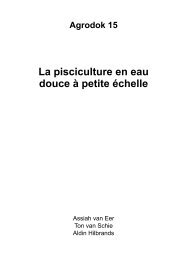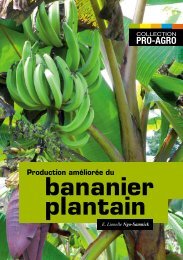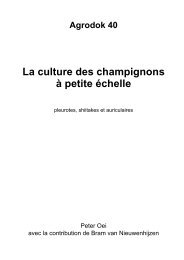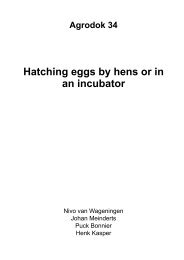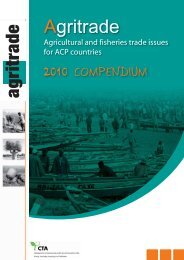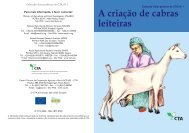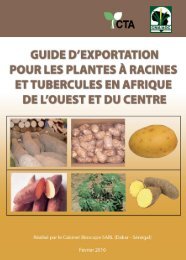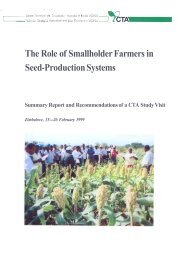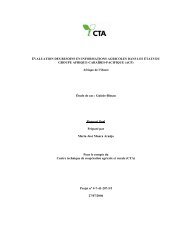La conservation du poisson et de la viande - Anancy
La conservation du poisson et de la viande - Anancy
La conservation du poisson et de la viande - Anancy
- No tags were found...
You also want an ePaper? Increase the reach of your titles
YUMPU automatically turns print PDFs into web optimized ePapers that Google loves.
pâte. <strong>La</strong> pâte est versée dans <strong>de</strong>s pots ouverts <strong>et</strong> exposée au soleil. Lesoir, les pots doivent être fermés pour empêcher l’intrusion <strong>de</strong>s insectes.<strong>La</strong> fermentation peut alors avoir lieu. On enlève le liqui<strong>de</strong> qui apparaîtà <strong>la</strong> surface. <strong>La</strong> pâte est consommable lorsque tout le liqui<strong>de</strong> estsorti.TrassiLe trassi est une pâte <strong>de</strong> <strong>poisson</strong> originaire d’Indonésie. Le trassi u-dang est fait avec <strong>de</strong>s crev<strong>et</strong>tes <strong>et</strong> le trassi ikan avec <strong>du</strong> <strong>poisson</strong>. Lescrev<strong>et</strong>tes ou le <strong>poisson</strong> frais sont mé<strong>la</strong>ngés à 15% <strong>de</strong> sel. Le mé<strong>la</strong>ngeest étalé sur <strong>de</strong>s nattes posées sur le sol <strong>et</strong> sèche au soleil pendant 1 à 3jours. <strong>La</strong> teneur en eau <strong>du</strong> <strong>poisson</strong> ou <strong>de</strong>s crev<strong>et</strong>tes baisse alors <strong>de</strong>80% à 50%. <strong>La</strong> masse est ma<strong>la</strong>xée <strong>et</strong> pilée pour former une pâte. <strong>La</strong>pâte est étalée en fines couches <strong>et</strong> mise à sécher au soleil. Elle est emballéedans <strong>de</strong>s cylindres faits avec <strong>de</strong>s feuilles <strong>de</strong> bambou ou <strong>de</strong> nipa.Elle mûrit jusqu’à l’apparition <strong>de</strong> l’o<strong>de</strong>ur caractéristique <strong>de</strong> trassi. 3kg <strong>de</strong> crev<strong>et</strong>tes donnent 2 à 2,5 kg <strong>de</strong> trassi. Du riz ou <strong>de</strong>s épluchures<strong>de</strong> pommes <strong>de</strong> terre sont parfois aussi ajoutés à <strong>la</strong> pâte. Le trassi nepeut jamais être mangé cru ; il doit toujours subir un traitement à <strong>la</strong>chaleur, cuisson ou friture, avant d’être consommé. Il est utilisé encondiment.Dans les pays <strong>du</strong> Sud-Est asiatique, on fait aussi fermenter <strong>de</strong>s <strong>poisson</strong>sentiers.Remè<strong>de</strong> <strong>de</strong> ColomboLe <strong>poisson</strong> (maquereau ou sardines maigres) est vidé (viscères <strong>et</strong>branchies), puis rincé à l’eau potable. Il est mé<strong>la</strong>ngé avec <strong>du</strong> sel (1 kg<strong>de</strong> sel pour 3 kg <strong>de</strong> <strong>poisson</strong>) <strong>et</strong> mis en pots. Pour faire baisser le pH,on ajoute au mé<strong>la</strong>nge sel-<strong>poisson</strong> <strong>de</strong> <strong>la</strong> pulpe séchée <strong>de</strong>s fruits <strong>du</strong> tamarin.Il faut 8 kg <strong>de</strong> tamarin pour 100 kg <strong>de</strong> <strong>poisson</strong>. Le <strong>poisson</strong> estmaintenu immergé dans <strong>la</strong> saumure à l’ai<strong>de</strong> <strong>de</strong> poids posés sur <strong>de</strong>snattes <strong>et</strong> <strong>la</strong>issé à fermenter pendant 2 à 4 mois. Ensuite, il est versédans <strong>de</strong>s fûts en bois. Il faut veiller à ce qu’il reste bien immergé. Le<strong>poisson</strong> ainsi fermenté se conserve pendant 1 an.64<strong>La</strong> <strong>conservation</strong> <strong>du</strong> <strong>poisson</strong> <strong>et</strong> <strong>de</strong> <strong>la</strong> vian<strong>de</strong>




